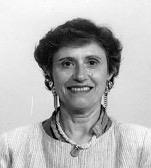Magda Ericson facts for kids
Quick facts for kids
Magda Galula Ericson
|
|
|---|---|

Portrait of Magda Ericson, CERN, Department of Theoretical Physics
|
|
| Born | December 18, 1929 (age 95) Tunis, Tunisia
|
| Alma mater | Sorbonne |
| Known for | Ericson-Ericson Lorentz-Lorenz correction |
| Spouse(s) | Torleif Ericson |
| Awards | Palmes Académiques 1978 Gay-Lussac-Humboldt-Prize 1992 Knight of the Legion of Honour 2015 Fulbright scholarship 1960 |
| Scientific career | |
| Fields | Condensed matter physics Particle physics Nuclear physics |
| Institutions | Massachusetts Institute of Technology (MIT) Centre national de la recherche scientifique (CNRS) University of Lyon European Organization for Nuclear Research (CERN) |
| Thesis | Étude des fluctuations d'aimantation dans le fer au voisinage de la température de Curie par diffusion des neutrons |
Magda Galula Ericson (born 1929) is a French-Algerian physicist. She was born in Tunisia. Her early research helped us understand how materials behave at special temperatures. This is called the Curie point. Later, she became known for developing an important theory. It is called the Ericson-Ericson Lorentz-Lorenz correction.
Contents
Amazing Discoveries
Magda Ericson's PhD work was about how slow neutrons scatter off iron. This was a very important experiment. It helped scientists understand "critical phenomena." These are special changes that happen in materials at certain temperatures.
Understanding Pions
Ericson is also famous for her work in nuclear physics. She studied tiny particles called pions. This area of study is now known as nuclear pion physics. She and her husband, Torleif Ericson, discovered something special. It's called the Ericson-Ericson Lorentz-Lorenz (EELL) effect. This effect helps explain how pions interact with the center of atoms (the nucleus). It also helps us understand other forces in the nucleus.
The EMC Effect
Magda Ericson is also a top expert on the EMC effect. This effect shows that the way quarks (even smaller particles) behave inside a nucleus is different from how they behave alone. Her work has been very important. Many other scientists have used her ideas in their own research. She is still doing research today!
School and Early Work
Magda Ericson was born in Tunisia. But she finished high school in Algiers in 1947. At that time, Algiers was part of France. After high school, she took special science classes. These classes prepared her for university. She studied at Lycée Bugeaud from 1947 to 1949.
In 1949, she took a national competition. She came in first place! This allowed her to go to a top school in Paris. It was called the École normale supérieure de Sèvres. In 1953, she won another national competition. This one was for physical sciences teachers.
Researching with Neutrons
From 1953 to 1959, she worked as a researcher. She was at the Saclay center in France. This center is part of the French National Centre for Scientific Research (CNRS). She mainly studied how slow neutrons scatter. She also looked at magnetism.
During this time, she worked on her PhD. She defended her experimental physics thesis in 1958. This was at Sorbonne University. Her results were groundbreaking. They showed how useful slow neutron scattering can be. It helps us learn about how matter is put together.
After this, her research position was not renewed. She also had some health issues. So, she decided to switch from experiments to theoretical research. First, she studied plasma physics. She received a Fulbright scholarship. This allowed her to spend a year at MIT. There, she worked with a plasma physics group. She even found an explanation for a strange plasma behavior.
Career and Later Research
After her time in the US, she came back to France. She became a lecturer at the University of Lyon. In 1967, she became a full professor there. She kept this job until she officially retired in 1995. Even after retiring, she continues to do research. She still publishes new scientific papers!
Since 1963, she has also been a visiting scientist at CERN. CERN is a famous research center in Europe. She works there part-time.
From Experiments to Theory
When she returned to Europe, she changed her focus. She moved from experimental physics to theoretical physics. She started working in a new field. This field combined nuclear physics and particle physics. She especially looked at the role of pions inside atomic nuclei. This was a great choice for her. She found that her new field had many similarities to her earlier work. For example, the Ericson-Ericson Lorentz-Lorenz correction for pions. She studied this in detail with Torleif Ericson in 1966. This paper has been cited by many other scientists.
She also studied how pions interact with nuclei. She found that the equations for pions were similar to Maxwell's equations. These are equations for how light and electricity work. This helped her understand how a basic property of neutrons changes inside a nucleus. It also explained some "quenching effects" seen in nuclear transitions.
In the 1980s, Ericson also pointed out that pion physics helps explain the EMC effect. More recently, she has studied how neutrinos interact with nuclei. This is very important for particle physics. She also explained something called the "axial anomaly."
Magda Ericson has been an active scientist for over seventy years!
Private Life
Magda Ericson married Torleif Ericson in 1957. He is a Swedish nuclear physicist. He has worked at CERN since 1960. They have two grown-up children. The Ericsons live in Geneva, Switzerland.
Magda Ericson is the aunt of a French mathematician. His name is Jean-Michel Bismut. Her cousin, David Galula, was a well-known military thinker.
Awards and Honors
 Knight of the Legion of Honour (2015)
Knight of the Legion of Honour (2015)- Gay-Lussac-Humboldt-Prize (1992)
- Prix Paul Marguerite de la Charlonie, a prize from the French Academy of Sciences (1987)
 Knight of the Palmes Académiques (1978)
Knight of the Palmes Académiques (1978)- Fulbright scholarship (1960)

